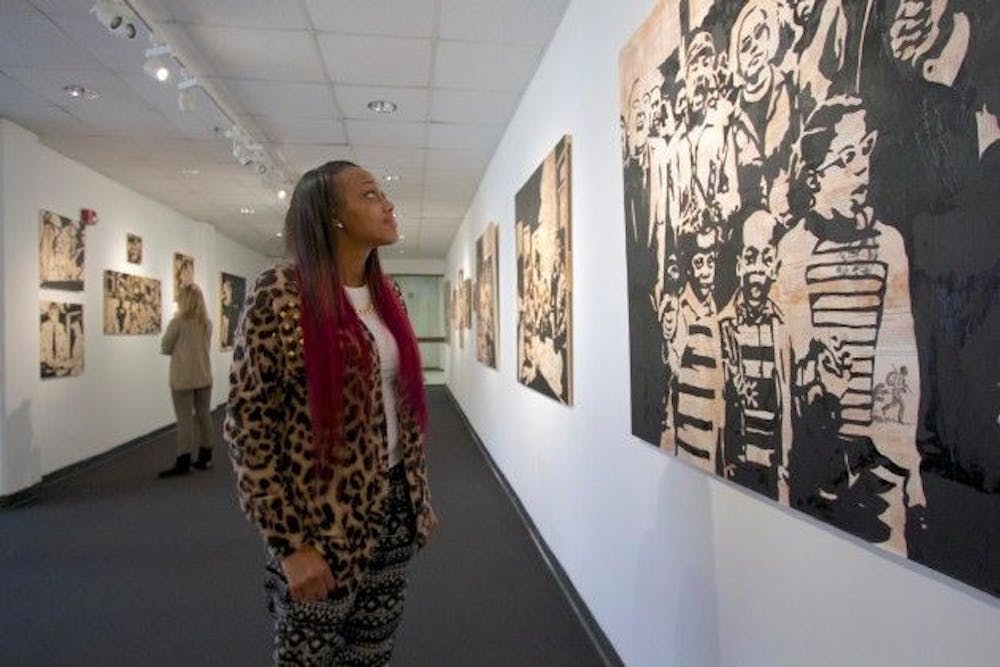Lawrence Matthews' III opening reception for his new exhibition, '"Reflections," was held at the Box Gallery in the Arts and Communication Building on Feb. 28.
The reception featured a series by Matthews that reflects upon the struggles and achievements within black history.
"When you look in the gallery, it goes through time, as far as issues and different struggles with Civil Rights, but these issues are still going and that's why this is important," Matthews, a senior art major, said.
Matthews noted Florida's Stand Your Ground law and the controversy surrounding it, as well as the many restricted rights that homosexuals are battling for all around the globe.
"I feel like there needs to be a resurgence of these movements to help correct issues like these," Matthews said.
The gallery features 18 of Matthews' pieces from his series, each focusing in on a certain moment in the Civil Rights era. However, the work being shown is only part of a collection that Matthews said he has been working on for the past year and a half.
"The exhibition shows all of these different issues and different people stepping in trying to change them. It's a big and constantly expanding series, this is only a snapshot of what I plan to do," Matthews said. "Each piece represents a specific time period and issue within the struggle. There are so many images and stories to left to tell."
The images Matthews chose to represent these certain events range from black boxer Joe Lewis winning the World Heavyweight Championship to the Black Panthers to a poverty-stricken mother and child in Harlem.
Many of Matthews' other paintings feature prominent leaders and figures within the Civil Rights era, such as Malcom X, Martin Luther King Jr. and Rosa Parks.
"I always look at artists who have thousands and thousands of paintings when they die, that's what they leave behind as their legacy, and I want to be one of those artists with that many great pieces to leave behind as mine," Matthews said.
Matthews starts with a wood-grain canvas covered with a collage of book pages from books written by prominent black authors from the '70s. Once the backgrounds are finished, Matthews then draws over them with black oil paint.
"It all started when some friends and I found this lady's destroyed house. We were taking some photos outside of the house because it was so cool looking, and eventually we decided to look inside the house."
Upon exploring the house, Matthews found an assortment of vintage records from the '60s and an assortment of books about Civil Rights, which he decided to take home to his fiancée.
The books found a new resting place in Matthews' garage, until he decided to give life to the half-century old pages again by continuing their purpose of liberation and story telling in his freedom-themed art.
"This woman was obviously somebody that was socially conscious, as far as her race was concerned, and obviously deeply educated in the subject," Matthews said. "I wanted to make something that would make her proud if she was still here, which is how a lot of this work started."
Matthews said that the main purpose of his art was to introduce this subject to people who may have not experience it before.
"The main focus of this series is the past and trying to reflect on that. A lot of the younger people today aren't really interested in the subject, which isn't necessarily their fault; it's not heavily mentioned in the school curriculums," Matthews said. "You kind of have to go out of your way to get this kind of knowledge."
Another piece from Matthews' collection won a 'Best in Show' award from the 31st Juried Student Exhibition a few weeks ago, which Matthews said was a huge honor, and is still in the Art Museum of the University of Memphis.
He believes it is important to consider black history a part of American history rather than its own category.
"There is no such thing as African-American history-it should be in unison with history. We're all together, but a lot of the time people want to categorize it as it's own branch," Matthews said. "We all built this country together, maybe on the backs of certain people, but nonetheless, all together."
Although Matthews' main focus within is art is to tell the stories of the past, he said that if people could get together and talk about these issues it might break down barriers and help people deal with similar issues today.
"People are dealing with these issues still today and they're still trying to earn their rights to be treated as people. They are still dealing with these things on a real level: discrimination, violence, stereotyping," Matthews said. "Obviously we're not quite where we need to be yet."
Matthews said he is mostly concerned with the foundations, noting we still have to work on the foundations of Civil Rights and preventing discrimination.
"If Obama is in the White House and people are still getting shot in their cars because somebody was threatened by their hip-hop music. I'm just more concerned with my little brother being able to walk around his neighborhood and not being worried about someone chasing him down and shooting him than who is in the White House," Matthews said.
Matthews' exhibition in the Gallery Box, which is open during the week from 10 a.m. to 4 p.m., officially opened Feb. 24 and will continue until March 17. He is looking forward to the opening reception and noted that there will be more to come in the near future.
"The main thing for me is this isn't about me. I want the work to breathe for itself and to cause dialogue between everybody there. Hopefully there will be a diverse group of people there, which is what the work is about," Matthews said. "This is the start of a lot of things to come."




